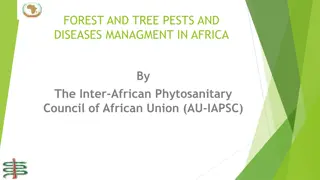Dante's Inferno Canto XIII: The Forest of Suicides
In Canto XIII of Dante's Inferno, Dante and Virgil venture into the Forest of Suicides in the seventh circle of Hell. They encounter sinners who have destroyed their own lives and substances, facing eternal torment. The imagery of twisted trees, Harpies, and relentless punishment paints a vivid picture of the consequences of self-destruction and violence.
Download Presentation

Please find below an Image/Link to download the presentation.
The content on the website is provided AS IS for your information and personal use only. It may not be sold, licensed, or shared on other websites without obtaining consent from the author.If you encounter any issues during the download, it is possible that the publisher has removed the file from their server.
You are allowed to download the files provided on this website for personal or commercial use, subject to the condition that they are used lawfully. All files are the property of their respective owners.
The content on the website is provided AS IS for your information and personal use only. It may not be sold, licensed, or shared on other websites without obtaining consent from the author.
E N D
Presentation Transcript
Canto XIII The violent against themselves
Introduction Canto XIII of The Inferno takes place in Round Two of Hell s Seventh Circle. The Seventh Circle is the first section of Lower Hell, reserved for the more atrocious sins. At this point, Dante has much less sympathy for the sinners than before, and is continuing to grow close with Virgil.
What Happened Dante and Virgil have recently come from Round One, where those violent against others reside. Nessus, a Centaur, has guided them over the river of boiling blood to reach a gnarled and twisted wood: The Forest of Suicides. Harpies and agonized moans litter the forest, yet Dante is more concerned by the seeming lack of sinners . Virgil tells him to pick a branch off of a tree. When Dante does this, a great wail arises from the tree, and it secretes blood. A human soul has manifested in this tree.
The Sinners and Their Sins This section consists of two main sinners: 1. The Destroyers of their own lives. 2. The Destroyers of their substances
The Sinners and Their Sins (cont) The Destroyers of their own lives: More commonly referred to as The Suicides , these sinners killed themselves. Since they never got the opportunity to ask for forgiveness before they died, they receive a low place in Hell. The sinners soul is twisted and transformed into a tree that is fed on by Harpies. The Harpies defile and scratch the trees, and the trees ooze human blood. The woods are silent until a tree starts bleeding, only then can one of the sinners cry out in pain and mourn over their torture.
The Sinners and Their Sins (cont.) The Destroyers of their substance: These sinners wasted everything around them with extreme violence. Meaning any resources they gained through means of cunning and grotesque atrocities. Ciardi notes that these sinners are typically only relatable to the Florentine politics of the time, and can be are not as relevant to society today. These sinners must run naked through the forest while they are chased by bitches. The bitches end up killing them and tearing them limb from limb, possibly as retribution for all they took from others. This process repeats eternally, for they have no other means of payment now.
Allusion The most prominent allusion in this section of the novel is the Harpy. Harpies are mythical creatures with the faces of women, but the bodies of birds. Commonly used interchangeably with the Furies, These creatures sole purpose is to desecrate all they come into contact with. They tear at the trees and force the Suicides to bleed. They croak eternally in the unnatural trees. (line 15)
Literary Devices Paradox; The Harpies, feeding on its leaves then, give it pain and pain s outlet simultaneously. (lines 101-102). These lines help describe what the torture means to the sinners. They used pain to exude their earthly woes, but now this pain is all they can experience for eternity. Simile: ...the wood leaped with black bitches, swift as greyhounds escaping from their leash (lines 125-126). These creatures chasing the sinners are so anxious to attack, they are like the fastest dogs alive escaping from their owners, and putting all ahead of them in danger.
The END
Works Cited 1. Alighieri, Dante, and John Ciardi. The Inferno. Signet Classics, 2009. 2. Dore, Gustav. Harpies in the Forest of Suicides. Bibloklept, England, France. 3. Mearlan, Jacob van. Medieval art of a harpy. Wikipedia, USA, 1335AD, Germany.


























